By GARY MORELLO
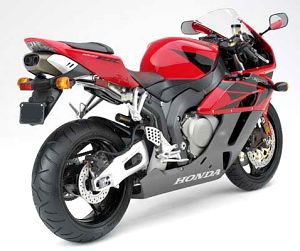
2004 Honda CBR1000RR
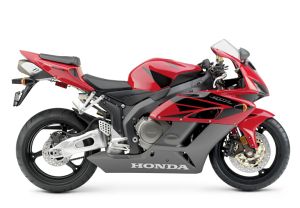
Expect an increase over last years peak power
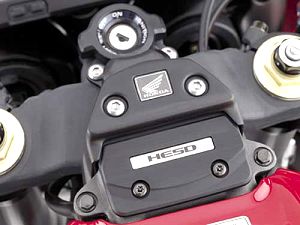
New for 2004: Honda's new steering damper
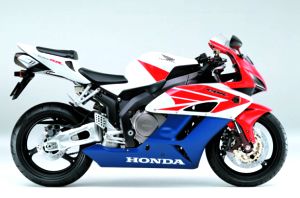
Honda's traditional R/W/B colour scheme is back
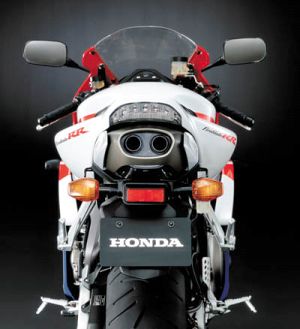
The tail end: Focussed and rather sexy too
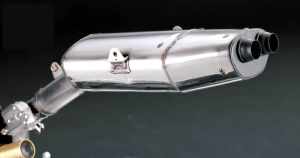
Honda's new servo-operated
shotgun is popular in Japan
|
The 1992 debut of the history-making CBR900RR Fireblade completely rewrote the book of Super Sport motorcycle design.
It was a remarkably compact and lightweight configuration; arguably the catalyst that sparked the expansion of the current litre-class Supersport category into what it is today, with the likes of Yamaha's R1, Kawasaki's ZX-9R and Suzuki's GSX-R1000.
Now Honda has decided to up the ante considerably by increasing the Fireblades engine capacity, in turn giving the GSX-R and YZF nameplates something to chew on: The brand-spanking CBR1000RR.
The starting point for this radical new departure in the Fireblade’s long history of development was never in question, however.
None other than Honda’s all-conquering new MotoGP powerhouse, the RC211V, held the key to the future evolution of the company’s premier Super Sport flagship; the very same machine on which this year’s impressive new CBR600RR is also based.
Like the CBR600RR before it, the main focus of the new CBR1000RR Fireblade strays away from the single-minded pursuit of absolute peak power or the lightest weight.
Specification figures can’t possibly tell the whole story about a motorcycle’s performance potential, since the overall handling and performance of a bike depends most on making efficient and effective use of the engine’s full power throughout its entire powerband, rather than simply concentrating on the big numbers.
Engine
The Fireblade’s totally new 998cc engine was designed from the ground up for World Superbike levels of performance.
Shorter and more compact than ever before, it provides a strong yet linear power delivery, with a new ram air induction system combining with a new Dual Sequential Fuel Injection system like that was introduced on the CBR600RR.
To start with, the Honda white coats decided to up the engine's size: Cylinder bores and pitch were left untouched in order to preserve the engine’s narrow overall width, but displacement was upped through an increase in stroke from 54mm to 56.5mm, for a total displacement of 998cc, which would also realise stronger torque throughout its wide powerband.
A fundamental key to creating high-revving, high-powered engines is the minimisation of both reciprocating mass and power-robbing friction. As always, in its never-ending quest for achieving more with less, the new CBR1000RR stands on the cutting edge of engine development with a new, leading-edge advance in piston design.
The RR’s lightweight new forged aluminium Slipper pistons feature a radical new surface preparation process applied to their side skirts that greatly reduces frictional losses as the pistons thrust up and down in the engine’s PMC cylinder sleeves.
No mere surface coating, this treatment literally shoots particles of pure, low-friction molybdenum into the side skirt faces of the piston with such high force and temperature that they are embedded deep into the surface of the aluminium with a chemical reaction that seals the material in place.
To help ensure that these hot new pistons keep running cool, new high-pressure oil jets provide a continuous stream to the underside of the pistons, with increased output for more efficient cooling.
The cylinder heads have also been re-jigged, and while its magnesium head cover and cam holders remain essentially unchanged, intake port angles were raised for a straighter injection and intake path, and a significant contribution to more responsive performance.
Included valve angles were also narrowed for a flatter squish band, with the current 12° intake valve angle reduced to 11° 20' and the exhaust valve angle reduced from 13° to 12° 10'. While valve diameters remain the same at 29mm for intake and 24mm for exhaust, the valves’ stems were slimmed from 4.5mm to 4mm for lighter weight and reduced friction. This important weight reduction also permitted the use of lighter valve springs, that keep valve actuation quick and accurate.
The Fireblade also features a new servo-controlled exhaust valve system that controls a new type of valve located inside the under-seat exhaust. By giving independent control over the flap located at the front mouth of the ram air intake, power and torque across the rpm range are significantly increased.
Positioned just above the top of the ’Blade’s new large-capacity radiator, and below its steering head, the large central duct at the front of the airbox provides a high pressure volume of cool, power-producing air at speed for a dramatic surge in midrange to high-speed power and performance.
This system provides excellent ram air performance for street and box-stock racing applications—although may require a bit more intake volume for full Superbike racing potential. Inside the new airbox, a pair of large cylindrical air filter elements replace the panel-type element used till now, providing a clean, unrestricted flow of air to the intakes.
Further optimising power output, the Fireblade’s new 4-into-2-into-1 stainless steel and titanium exhaust system features a new exhaust valve designed to achieve a superb balance of low-to-midrange power delivery and effectively modulated sound output, as well as improved driveability.
The cable-actuated valve is located just before the upward bend in the exhaust pipe and is operated by a servomotor that receives control signals from the central CPU. This system significantly improves power and response at low, medium and high rpm.
Besides enhancing overall performance, the new valve is also fully 770g lighter (at 479g compared to 1,249g) than the Honda Titanium Exhaust Valve (H-TEV) system it replaces. The new CRB1000RR also makes use of twin fuel-injectors per cylinder, called PGM-DSFI Dual Sequential Fuel Injection System.
Simply put, the Fireblade’s second set of injectors are programmed to only operate when the throttle is opened wide at engine speeds of over 5000rpm. As a result (as in Formula One race car engines), the cooling period and distance of the incoming air/fuel mixture is increased, lowering the temperature of the intake air. This creates a denser mixture that improves volumetric efficiency, creating very strong acceleration power.
Styling
Brilliantly adding to the Fireblade’s sleek and speedy MotoGP look are a slim pair of "Line Beam" headlights like those first introduced on the dynamic new CBR600RR.
Projecting a more modern and boldly aggressive image, these low-profile units feature a compact, yet high-illumination multi-reflector design projecting through clear lenses that are less than half the size of the dual headlights used on most road bikes, yet provide a brilliant night-time view of the road ahead while imparting a more dynamic look to the front of the machine.
Elsewhere, the Fireblade’s indicators and slim, lightweight LED taillights were also borrowed from the 600RR, further contributing to its sleek look of aggressive performance. Other changes are evident in the new design of the ’Blade’s cast aluminium pillion steps and holders, and in the front cowl’s lighter-weight cast aluminium stays.
With a broad yet thin seat pad provided for the rider, the detachable pillion seat can be easily replaced with an optional colour-matched cowl to provide solo riders with a more completely focused racer look. Underneath, a more compact carrying space provides room for a U-lock, gloves, and a few other small essentials.
Suspension/Handling
The Fireblade’s highly rigid and responsive cartridge-type inverted front fork retains essentially the same components as the current version.
Front fork offset, however, was reduced from 30mm to 25mm, and trail was increased 5mm. The Fireblade’s new Honda Electronic Steering Damper, mounted directly atop the front fork upper triple-clamp, effectively enhances high-speed performance while maintaining low-speed handling for easier riding across a wide range of conditions.
Although the Fireblade has traditionally used axial-mounted four-piston callipers, the new Fireblade’s new front brake system now features a set of Tokico radial-mount callipers.
These new callipers feature distinctive turret-like mounts that seem to jut directly outward from the front axle, onto which the callipers bolt straight down. The new callipers are held together by three lateral bolts for a more rigid design that provides both stronger grip and more even pressure distribution across the entire surface area of the pads for highly efficient braking with excellent feel at the lever.
Their improved performance permits smaller rotors to be used, which have been reduced in diameter from 330 to 310mm while still realising improvements in both braking ratio and performance, not to mention providing a small but important contribution to the Fireblade’s lighter and more responsive handling.
Auxiliary
The Fireblade’s compact and lightweight new instrument panel features a more compact, six-sided design similar to that on the RC211V, with LCD readouts positioned around a large, new tachometer dial.
The surrounding LCDs offer clearly visible indications for the large-digit speedometer, a dual-trip and odometer readout, a digital coolant temperature gauge and a clock. In addition, the displays are concentrated at the centre of the panel, making them easy for the rider to read.
Besides the usual selection of indicator lights, the panel also features a new adjustable shift indicator which can be set to between 5000 and 11500rpm for an instantly recognisable indication of the optimal shift point, especially useful in racing applications.
This indicator light also features three distinct selectable blinking patterns (ON, slow, or fast flashing) and three brightness levels for easier recognition. Likewise, as a sign of the new Fireblade’s high-performance intent, its tachometer dial also features a new redline zone, which was extended upward 2000rpm, from 11500 to 13500rpm.
The right-side handlebar switch pod is now no longer integrated with throttle, and is instead a separate unit taking up position next to the throttle, thus facilitating replacement or removal for racing applications.
So, what's to make of this new 'Blade? Well, quite a lot. Honda's been sick and tired of playing second fiddle to Yamaha and Suzuki and is now evening the odds with another 100cc of grunt. Will this and the other new tricks work for Honda? Only time will tell...
Visit The Honda CBR1000RR WebPage
|

